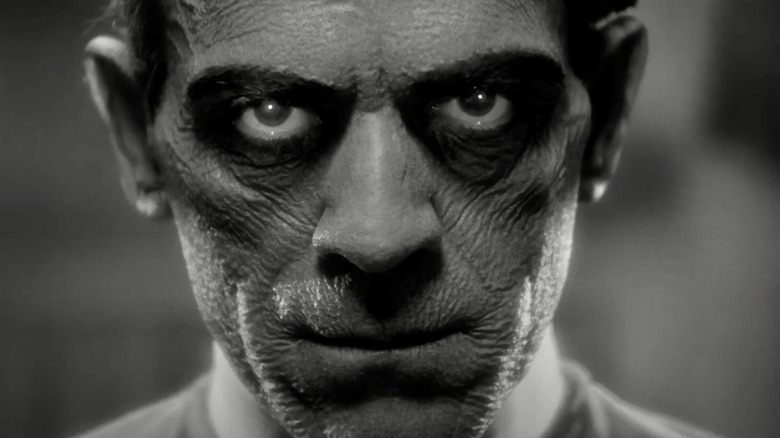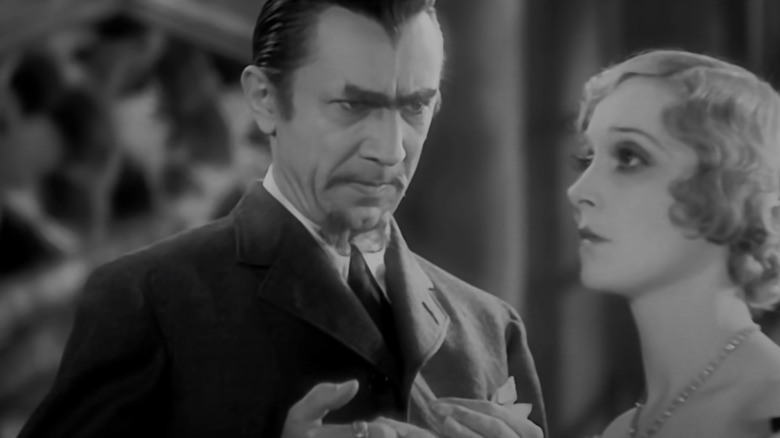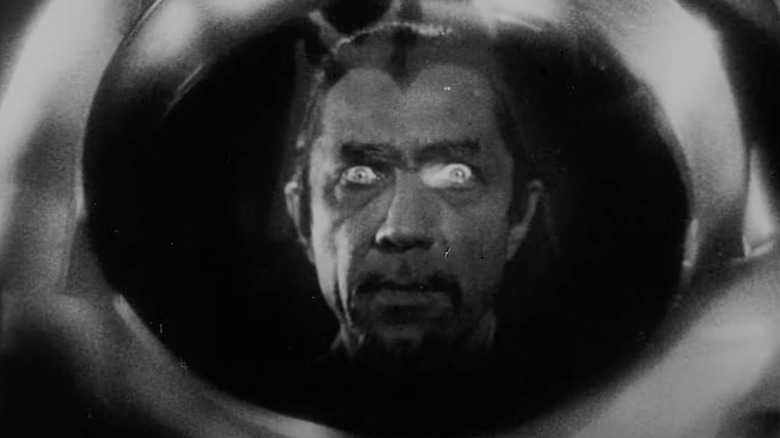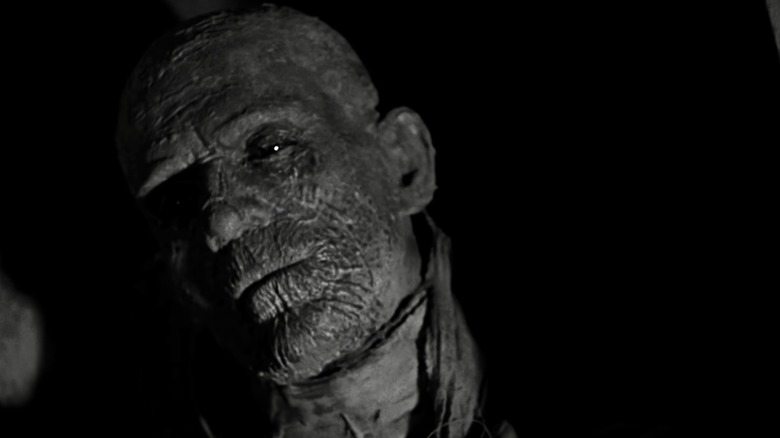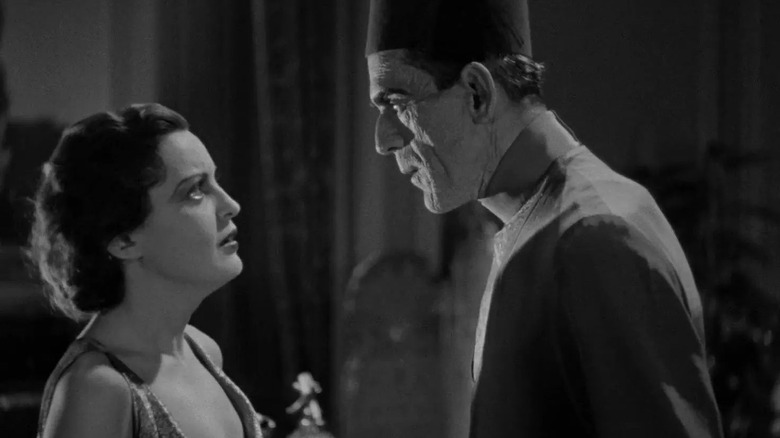How Dracula And Vampires Influenced Other Movie Monsters, From Zombies To Mummies And More
On the silver screen, vampires are among the oldest inhabitants of the monster population, with Count Orlok, the first unofficial movie Dracula, waking from his silent film coffin in 1922. However, as 2022, the Year of the Vampire, rolls on, it's worth remembering that the "Nosferatu" bloodline extends beyond bloodsuckers to incorporate other horror genres. From the earliest days of Dracula, when Bela Lugosi first gave voice to the Count in the 1931 sound adaptation of Bram Stoker's novel, the vampire family tree had already begun to branch off into new expressions of terror sans fangs.
Fresh off "Dracula" in 1932, Lugosi starred in the first zombie movie, Victor Halperin's "White Zombie." That same year, key plot elements and cast and crew members from "Dracula" carried forward into another Universal Classic Monsters film, "The Mummy," informing its franchise for decades to come.
What we now think of as meta and comedy horror also spun off from early films like "Mark of the Vampire" in 1935 and "Abbott and Costello Meet Frankenstein" in 1942. Both of those movies featured Lugosi in supporting roles.
Then, came Richard Matheson's 1954 post-apocalyptic vampire novel, "I Am Legend," which inspired director George Romero when he was making the first contemporary zombie film, "Night of the Living Dead." Romero sought to distinguish his zombies (which he didn't actually call zombies) from those of Haitian folklore, but he was still drawing from vampire source material, a book that has yielded three film adaptations: "The Last Man on Earth," "The Omega Man," and "I Am Legend." It's not a stretch to say that zombies mutated from vampires on celluloid.
With these considerations in mind, let's take a look back at the evolution of some key post-vampire forms of horror, giving special emphasis to the zombie genre and the "Mummy" franchise, both of which are celebrating their 90th anniversary this year. Pause "The Walking Dead" and "Moon Knight," those zombified and mummified Marvel shows you're streaming, and let's take a trip back to where it all started in 1932.
White Zombie in the house of Dracula
Like Black Sabbath, the band White Zombie, where director Rob Zombie got his musical start, took its name from an old horror flick that was more obscure pre-internet. What makes "White Zombie" such an intriguing artifact besides it being the first zombie movie is that it shows the cinematic origins of "the living dead" as people stuck in soul-sucking jobs. The Black coachman (Clarence Muse) describes them as "corpses taken from their graves, all made to work in sugar mills and fields at night."
Lugosi's character, Murder Legendre, exploits them for menial labor. He's basically an evil slavedriver in the literal plantation sense and the head vampire by a different name. Like Dracula, Legendre can seemingly control animals, summoning vultures to his window, and his hands and eyes hold a hypnotic power over people. Chalk it up to Lugosi's background playing a Svengali-like figure in the pre-"Dracula" German film, "Hypnosis."
"White Zombie" was filmed on some of the same sets as "Dracula." The cavernous hall and stairs from the Count's castle make an appearance here, as if to remind the viewer that Haitian Vodou and the house of Dracula are where the zombie idea first arose. Technically drugged, not dead, these proto-walkers and shamblers and forebears of "The Serpent and the Rainbow" live only to do their voodoo master's bidding. As Legendre explains, "They work faithfully and they are not worried about long hours."
The title "White Zombie" refers to a white woman — not your usual zombie, it seems to say. Be it Transylvania or Haiti, there's a side to the vampire and zombie mythos in older films especially where the horror all seems to stem from the mind of an ethnographer who's just disrespectful and ignorant of other cultures. "White Zombie" is no exception to this, but it is what is (that being a 90-year-old, non-PC movie).
Right off the bat, "White Zombie" has a jumpy white couple in a "Dracula"-esque carriage plowing through a funeral, aghast at the backward native customs. A missionary with a calabash pipe, sounding like he's dismissing the country wholesale, tells them, "Haiti is full of nonsense."
Those who eat flesh and drink blood
Like Mina Murray and Jonathan Harker — the classic "Dracula" couple — Madeleine and Neil (Madge Bellamy and John Harron) are engaged to be married, but Legendre aims to get between them. His worker-drone zombies are brain dead, which is maybe why their descendants developed a taste for brains. Though of course, having them eat flesh, the way vampires drink blood, also positions them as the other natural half of an unholy communion rite, perpetrated all across horror.
These irreligious creatures aren't going to settle for Jesus Christ's body and blood. They want to devour the whole human race. There's even a moment in "White Zombie" where Lugosi's quasi-blackface (in reality, wine-face) is glimpsed in a soon-to-be-zombie's wine glass, as if to show that Dracula truly is the zombie All-father.
Zombies and vampires thereby establish themselves as cousins, yin-yang monsters farming humans for food and drink. Interestingly, Legendre's zombies can regain their souls, but if they did, he believes these newly restored humans would tear him to pieces ... rather like modern, cannibalistic, fast-running zombies.
"White Zombie" contains a reference to the "land of the living dead," which anticipates the titles of future Romero movies, beginning in 1968 with the one where they gather for a black-and-white barbecue of human meat. In "Night of the Living Dead," all the zombies are white and the hero, Ben, is Black. Duane Jones plays him, and five years later, he would star in Bill Gunn's arthouse vampire film "Ganja & Hess." Another five years after that, in 1978, Romero would turn the zombie metaphor on its head again, using it as a commentary on consumerism in "Dawn of the Dead."
In "White Zombie," Dr. Bruner (Joseph Cawthorn) plays the Van Helsing who knows all about zombies and their surprising legal precedents. He says, "There are superstitions in Haiti that the natives brought here from Africa. Some of them can be traced back as far as Ancient Egypt." The deeper we go with this vampire archeological dig, the more obvious it becomes that "Queen of the Damned" wasn't the first movie to excavate an undead being with Egyptian roots.
Van Helsing, meet The Mummy
"The Mummy," starring the great Boris Karloff, was the third Universal Classic Monsters film, after "Dracula" and "Frankenstein," which came back-to-back in 1931. Karloff played the Monster in "Frankenstein," and by 1932, he was so famous that he received mononymous billing as KARLOFF in the movie poster for "The Mummy."
While Imhotep, the Mummy, forged his own path, driving men to madness with the very sight of his walking form, his first movie is still derivative of "Dracula" in some ways. It begins right with the opening credits, which take a direct cue from those in "Dracula" by utilizing the same piece of music from the Russian ballet "Swan Lake."
Then, there is the cast. As the occult expert, Dr. Muller, in "The Mummy," Edward Van Sloan is essentially playing a new version of his "Dracula" character, the aforementioned vampire-hunter extraordinaire, Van Helsing. Had Universal's Dark Universe plans not imploded after the 2017 "Mummy" film, it's possible that a modern iteration of Van Helsing could have very well faced both Dracula and Imhotep in a 21st-century shared universe.
It's subtler in "Dracula" than "The Mummy," where the visible effect of tampering with cultural artifacts is to bring down a curse on colonial powers, but there is a streak of imperialism and Eurocentrism running through these old films. Again, they are products of their time. In "The Mummy," as in "Dracula" and "White Zombie," the foreign ghoul has set his sights on a white woman — Zita Johann instead of Helen Chandler — with a love interest played by David Warren (who filled the John Harker role in "Dracula.")
Though Zohann's character is half-Egyptian, she herself was Austrian-American, while Karloff was English and Lugosi was Hungarian. Imhotep is Egyptian instead of Transylvanian or Haitian, but like Dracula with Renfield, he also recruits a servant, The Nubian (Noble Johnson), from the ranks of the civilized. Meanwhile, the greatest threat in "Dracula" from coming into contact with an exotic vampire Other seems to be that he will besmirch the good honor of a Victorian gentlewoman.
Reincarnation and romance
"The Mummy" was directed by Karl Freund, who served as the cinematographer (and possibly uncredited co-director to Tod Browning) on "Dracula." It was also written by John L. Balderston, who did the American revision of Hamilton Deane's Irish stage play, "Dracula," on which the 1931 "Dracula" film was based.
Imhotep is driven by his love for Princess Ankh-esen-amun. It was for her that he was bandaged and buried alive — in a sarcophagus, not unlike a vampire in its coffin. After stirring back to life, he comes to believe that she has been reincarnated in the form of Johann's character, Helen Grosvenor. Den of Geek speculates that "The Jewel of Seven Stars," a lesser-known Stoker novel, may have also influenced "The Mummy" and the New Woman politics of Helen's ultimate rejection of Imhotep.
In 1959, "The Mummy" again followed Dracula with some of the same principal cast and crew members, as Terrence Fisher, Jimmy Sangster, Peter Cushing, and Christopher Lee, the director, screenwriter, and stars of the 1958 Hammer film "Horror of Dracula," all reteamed for their own Egypt-to-England terror tale. Karloff, meanwhile — after running on a parallel track with Lugosi for so long — would finally play a vampire in "The Wurdulak" segment of Mario Bava's 1964 horror anthology, "Black Sabbath."
Sixty years after the first "Mummy," when "Bram Stoker's Dracula" arrived, it would feature similar elements of reincarnation and romance, with Winona Ryder playing both Mina Harker and Elisabeta, the earlier lost love of Gary Oldman's Dracula. In the 1999 "Mummy" film, starring Brendan Fraser and Rachel Weisz, Ankh-esen-amun underwent a slight name change to Anck-su-namun, with Patricia Velásquez assuming the role and Arnold Vosloo taking over as Imhotep. Writer-director Stephen Sommers steered the franchise in a frothier, more Indiana Jones-like, action-adventure direction.
The original "Mummy" with Karloff was inspired by the real-life opening of King Tut's tomb in 1922, the year "Nosferatu" brought Dracula to Germany as Orlok. Yet with so much of Dracula's history folding into Imhotep's, one can't help but feel that the Mummy and his whole strand of horror are scions of vampire DNA, much like zombies. This is an oversimplification, but it extends to other sub-genres.
Meta Mark of the Vampire
At 60 minutes, "Mark of the Vampire" is below the usual feature length, but it's been called the first meta horror film. "Dracula" director Browning, now well-versed in cobweb-and-critter-infested castles, uses Lugosi mostly as window dressing this time around, rebranding him with a distinctive head wound as Count Mora. Carroll Borland joins him as another pseudo-vampire, Luna, who inspired Lily Munster's look in "The Munsters" TV show (now the subject of a Zombie film adaptation).
In reality, both Mora and Luna are actors who help stage an elaborate ruse to draw out an all-too-human murderer. This late-breaking twist doesn't entirely hold up, but it anticipates the parlor tricks of "The Cabin in the Woods," a film in which control-room engineers have an entire whiteboard of horror permutations plotted out as they stage their own ruse in the name of ritual sacrifice.
"Mark of the Vampire" laid the groundwork for such self-aware movies and is remarkably post-modern in its attitude toward vampires. It has characters laugh off the idea of vampires coming out of their coffins in castles to drink blood at night. One of them says, "Forget your absurd old superstitions. This is 1934!"
Lionel Barrymore, who plays Professor Zelen — yet another Van Helsing-like occult expert — was the great-uncle of Drew Barrymore. This adds another layer to her appearance in Wes Craven's "Scream," where the killers, two toxic horror fans, pull a reverse "Mark of the Vampire." Genre expertise now fuels murder games as the fans quiz others on their horror knowledge and attack them with knives in the guise of Ghostface. Barrymore, their first victim, was keeping up her family legacy as she furthered the meta horror continuum.
"Mark of the Vampire" uncloaked the horror genre's inherent artifice. There are hints of comedy in it, such as when characters freak out over a moving suit of armor (which turns out to have a cat crawling up through it). "Abbott and Costello Meet Frankenstein" brought the comedy out in full force, and it was the only time Lugosi officially reprised his role as Dracula. At the end of "Mark of the Vampire," when he says, "I gave all of me, I was greater than any real vampire," the same holds true for him as head vamp and any number of meta minions or movie monsters that followed in Dracula's wake.
